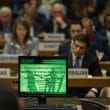When states fail to address incapacitants
By Ralf Trapp, May 9, 2008
Discussions of security risks will eventually have to take account of the readiness of governments to address them and agree on practical solutions. The Second Review Conference of the Chemical Weapons Convention (CWC), which included representatives from 114 national governments, has just completed its work–how did it deal with the issues identified in this roundtable?
Several countries raised the possible implications of using incapacitants for law enforcement purposes, but the conference took no action. And it did not set up a mechanism, such as the advisory panel suggested by Jonathan Tucker, to further evaluate the matter. This inaction does not preclude future discussions within the Organisation for the Prohibition of Chemical Weapons (OPCW), which is responsible for implementing the convention, but it may make those discussions more difficult. I would be skeptical about pursuing the debate further through the OPCW's Scientific Advisory Board. Some representatives at the recent review conference attempted to create a "filter" between the advisory board and the OPCW's political organs. In the end, it requested the OPCW's director-general to provide advice on how governmental experts can be involved in the interaction between the advisory board and the policy making organs of the OPCW. In any event, the issue of incapacitants is not primarily about new science, which is the domain of the advisory board, but about legal boundaries.
I agree with Alan Pearson that any further debate needs to start by evaluating the core principles underlying the CWC. The question is whether states can agree on criteria to determine when types and quantities of toxic chemicals are no longer consistent with law enforcement. I doubt whether debating the toxicity of chemicals in itself is of much use as Fidler seems to suggest (see Pearson's first posting in this roundtable). The other idea suggested, namely that one can control the effects of agents (and use controllability to establish which agents are legitimate) is at odds with the complexity and diversity of human beings and the unpredictability of operational conditions under which such weapons would be used. States may need to address other factors such as dissemination methods, delivery systems, tactics, and how to ensure transparency in activities that may well be perceived by others as the beginning of an offensive chemical program.
In general, the delineation of legitimate uses would have to be set in the context of the broader undertaking not to develop, produce, stockpile, or use chemical weapons. This is the crux of the problem. If one accepts that toxic chemicals can be weaponized for law enforcement purposes, how does one draw that line?
I cannot predict the outcome of this larger discussion, but the solution needs to be practical, scientifically sound, and consistent with the core principles of the CWC. I am skeptical about that solution taking the form of agreed criteria, standards, and methods to determine whether a toxic chemical or delivery system is consistent with law enforcement purposes. That would suggest an essentially open-ended approach where compliance would rest on how individual states interpret and apply these criteria.
On the related question of how the industry verification regime of the CWC should evolve further, the Review Conference gave some general guidance but failed to conceal significant disagreements between States Parties about which types of activities and facilities pose a risk to the CWC. New initiatives, along the lines suggested by Tucker, were given little room for discussion.
One piece of good news did come from the conference. In the context of reviewing the verification of "other chemical production facilities," the conference noted "the desirability of directing inspections towards facilities of greater relevance to the object and purpose of the Convention and of removing irrelevant facilities from the declarations and inspections," and asked the OPCW's director-general to explore options on the issue. This process could create an opportunity to further the discussion of risks associated with bioregulators and peptides. But I'm not overly optimistic, as proposals must be consistent with the present set of provisions for other chemical production facilities, meaning there will be no new declaration requirements or verification provisions.
In his latest comment, Tucker raised the issue of genetically engineered bacteria as a delivery vehicle for bioregulators. I agree that this belongs in the realm of the Biological and Toxin Weapons Convention. I would argue that the common understandings developed by its States Parties over the years ensure that such bioengineered delivery systems are covered under its prohibitions, but of course there is no international routine system to verify treaty compliance.
Finally, Tucker raised the potential use of bioactive peptides in interrogations of alleged criminals or terrorists and asked whether ongoing academic and pharmaceutical research on bioactive peptides that regulate neural circuits in the brain may produce new drugs that could enhance interrogation in a reliable and predictable manner. I don't want to speculate how likely that is from a scientific point of view, but whether the use of such compounds would be legitimate under the CWC is only half the question. Even if it was considered lawful within the CWC framework, legitimacy should involve a broader examination of medical risks as well as ethical questions related to interfering with the personality and cognition of individuals for law enforcement purposes.
Topics: Biosecurity
Share: [addthis tool="addthis_inline_share_toolbox"]














